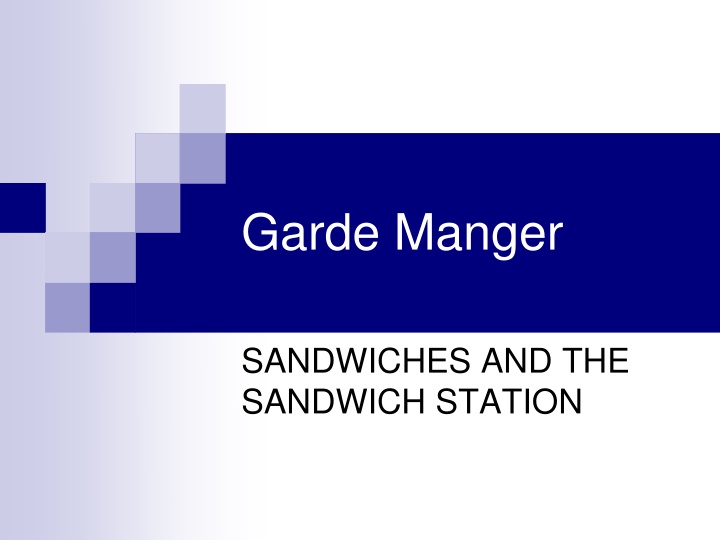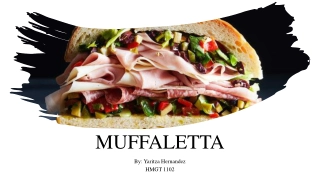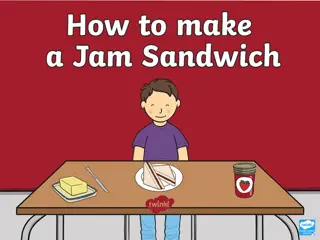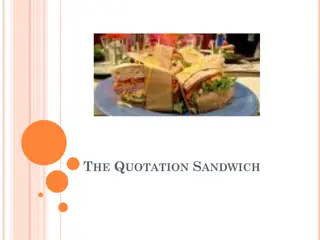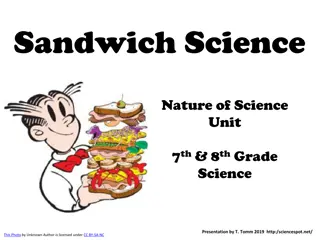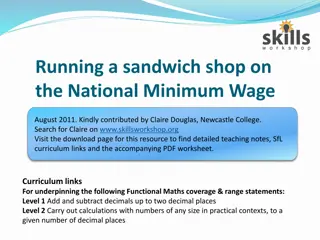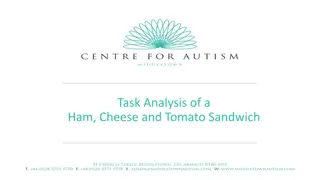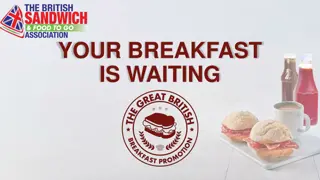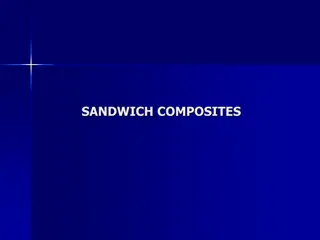Exploring the World of Sandwich Making
Discover the rich history, essential elements, and diverse types of sandwiches. Learn about the cultural importance and convenience of sandwiches in American dining habits. Explore different bread options, spreads, fillings, and garnishes that make each sandwich unique. From the classic PB&J to gourmet creations, this guide will enhance your sandwich-making skills.
Download Presentation

Please find below an Image/Link to download the presentation.
The content on the website is provided AS IS for your information and personal use only. It may not be sold, licensed, or shared on other websites without obtaining consent from the author.If you encounter any issues during the download, it is possible that the publisher has removed the file from their server.
You are allowed to download the files provided on this website for personal or commercial use, subject to the condition that they are used lawfully. All files are the property of their respective owners.
The content on the website is provided AS IS for your information and personal use only. It may not be sold, licensed, or shared on other websites without obtaining consent from the author.
E N D
Presentation Transcript
Garde Manger SANDWICHES AND THE SANDWICH STATION
OBJECTIVES: You will be able to: Recall and give examples of different types of sandwiches Explain the role of different sandwich ingredients Compare sandwich assembly methods and sandwich stations Demonstrate preparation of several types of sandwiches Demonstrate sanitation procedures for preparing sandwiches
Why sandwiches? Are important part of America s eating habits Eat sandwiches at home, school and work Convenient don t need flatware to eat Portable fit into busy lifestyles Prepared from fast food to fine dining!
CULINARY HISTORY Variations of sandwich have been around since Biblical times Legend has that Englishman, John Montagu, the 4thEarl of Sandwich invented the sandwich in 1765. Used bread slices to hold his meat so he could eat while playing cards
PB&J - Yum Mid 1800 s a St. Louis Doctor came up with idea for peanut butter Concerned about patients who could not chew meat. Ground up peanuts as protein alternative 1928, sliced bread invented. WW II soldiers given rations of PB and Jelly put together to create an American Classic!
Basic elements of sandwiches 4 parts to any sandwich the building blocks Bread Spread Filling Garnish
Bread Choose a fresh bread Bread must hold filling without falling apart Standard loaves, wheat, rye, white, etc. serve as base for most Pullman loaf Standard loaf baked in rectangular pan , easy to slice, standard slice is square on all sides
Other types of popular breads Kaiser Roll round, crusty roll Focaccia Flat Italian bread flavored with herbs and oil Pita Flat, Middle Eastern pocket bread Tortilla flat, round unleavened bread of Mexico Croissants flakey, buttery pastry Hot Dog/Hamburg Rolls created for the product
SPREADS Spreads are thick, paste-like ingredients applied to the bread Usually high in fat use sparingly Butter, margarine, cream cheese and mayonnaise are examples Add moisture, flavor and keep wet fillings from soaking the bread
FILLINGS Makes up bulk of sandwich. Sandwich often named after the filling Corned Beef, Peanut Butter & Jelly Most common fillings: Meat, poultry, seafood Cheese Vegetables Nut Butters Bound Salads such as Tuna
GARNISHES Decorative, edible accompaniments Make sandwich attractive and flavorful Choose flavor that complements the sandwich Vegetables good choice cooked, raw or pickled
TYPES OF SANDWICHES/COLD AND HOT COLD SANDWICHES Closed Filling between 2 slices bread Open Faced Filling on one slice bread Rolled and Wrapped - Heros (subs) Canapes Tiny open faced sandwich Finger Sandwiches tea sandwiches, trimmed crusts
TYPES OF SANDWICHES/HOT HOT SANDWICHES All or part of sandwich is hot Sandwich with hot filling Grilled or griddled grilled cheese, burgers Pressed - panini Hot open faced Deep or shallow fried Monte Cristo
SANDWICH ASSEMBLY (mise en place) Three basic assembly strategies Made to order ala carte Self-service sandwich bars Sandwich assembly lines ALL MUST BE DESIGNED FOR SPEED AND EFFICIENCY
A La Carte Prepared when ordered All ingredients in easy reach Linear work flow left to right or right to left All spreads have a spatula Cutting board that is large enough to assemble several sandwiches Serrated knife Proportioned ingredients (saves time and money)
Assembly line set up Bread Spread Main ingredients Supporting ingredients Plates and toothpick, wrapping stations, etc. (THINK SUBWAY)
Maintaining Safety and Sanitation Disposable gloves required when handling ready to eat Refrigerated wells keep ingredients cold Food below 41 degrees Take temps near tops of wells because that area will warm up first
Sandwich Bar Make your own sandwich Ingredients kept on ice below 41 degrees Need sneeze guard to plexiglas shield to maintain sanitation Keep well stocked and clean
Assembly Line when preparing large quantities Each person performs a repetitive job Speeds up production Cooks line up on one or two sides of table Tasks is performed and passed on to another team member Example: Person 1 spreads mayo, person 2 places ham, 3 places cheese, 4 spreads mustard, 5 wraps and packages
Assembly Line Refrigerate until needed Wrap sandwiches in plastic before to avoid drying out ingredients Tea sandwiches particularly prone to drying out.
Serving Sandwiches Sandwiches are served cut (exceptions are hot dogs and burgers Cutting makes it easier to eat, more attractive presentation
